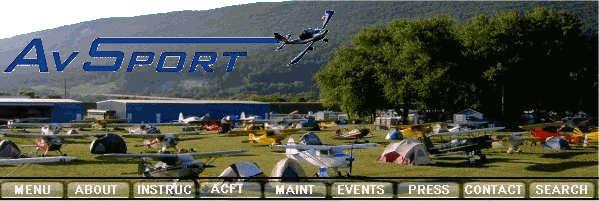
AvSport of Lock Haven -- 353 Proctor Street, Lock Haven PA 17745

Col. William Robert Fuchs, USAF (retired), was born in Pittsburgh and grew up in the south hills of that city. While studying mechanical engineering at Penn State University from 1936 to 1941, he won a free airplane ride in a horse race. Bill learned to fly in the fall of 1937 at the State College Air Depot in Boalsburg, entering the US Army as a flying cadet in June 1941, receiving his wings on December 27, and was commissioned as a 2nd Lt. on 1 January 1942. That June he married his Penn State sweetheart, Alice Shutts. They had a son and a daughter.
During WWII, Bill served as a flight instructor in single engine, twin engine, and four engine airplanes. After the war, he went on inactive reserve status, spending a semester at the University of Michigan studying aeronautical engineering. He accepted an offer to teach aeronautics at Drexel University in Philadelphia. Bill re-entered the Army Air Corps as a Captain in June 1947, and was assigned to the Air Force Institute of Technology as an instructor of thermodynamics.
In 1949 the Army needed experienced four-engine pilots to fly the Berlin Airlift. Bill was transferred to Great Falls, MT for C-54 training, and then shipped to Germany. He returned to the US in September 1949, as the airlift was winding down.
The US Military Academy said they would like to have Bill as an instructor the next year, so the Academy arranged for Bill to go to Bucknell University to earn his masters in mechanical engineering. In June 1950, he was assigned as an instructor in thermodynamics and fluid dynamics at West Point.
Three years later Bill was transferred to Randolph Field TX, to be checked out in the B-29, pick up a combat crew, and go to Korea. The night before he was scheduled to leave, the Korean War ended and his orders were changed, sending Bill to Tuscon to be an airplane commander in KC-97 tankers for the Strategic Air Command.
In the Spring of 1955 Bill was asked to help start the Air Force Academy as a mathematics instructor. He reported to Lowry Field, the original location of the Academy, and taught math there for a year. He was selected by General Harmon to oversee the design and construction of the thermodynamics laboratory at the permanent campus in Colorado Springs. Bill started teaching thermodynamics there when the first cadets became juniors. He and his wife Alice started a soaring program at the Academy, teaching cadets to fly sailplanes.
In June 1960 Bill received orders to serve as an exchange officer with the Royal Canadian Air Force in Ottawa. As an engineering officer, he continued to fly, in RCAF airplanes. He was next posted to FAA Headquarters in Washington as assistant to the Chief of Engineering and Manufacturing. He earned his commercial helicopter license, and took the FAA course in the Convair 880 4-engine jet transport. His next assignment would have been a staff job at the Pentagon, so Bill opted to retire from the military after 24 years of service, and accept a job where he could get lots of flying.
Bill and Alice moved to Lock Haven PA in 1963, where Bill became FAA Coordinator at Piper Aircraft, and later Administrator of Aircraft Safety. Bill retired from Piper in 1980, after 14 years of service.
Bill and Alice had built a hangar at the Lock Haven Airport in the 1970s, and ran a flight school there until 1994, when Alice suffered a stroke and had to give up flying. Along with his friend Bob Gunsallus, Bill continued building and flying aircraft of his own design, and in fact was working in his hangar up until just a few days before his death from a stroke at age 92. During the final months of his life, Bill became a mentor to H. Paul Shuch, AvSport's Chief Flight Instructor, providing him with invaluable advice and encouragement in establishing a new flight school at Piper Memorial Airport.
Bill's ashes have been buried on the campus of the US Air Force Academy.
If you can drive, you can fly!
Copyright © AvSport LLC, a subsidiary of Microcomm Consulting This page last updated 1 January 2024 |
Top of Page |